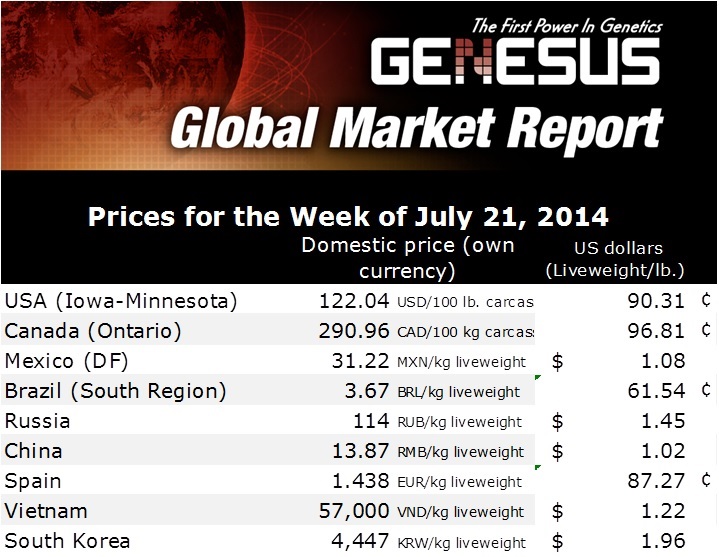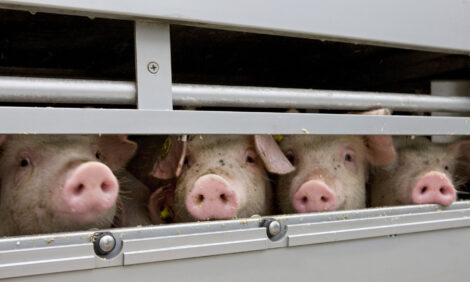



Viet Nam: Hog Market
VIET NAM - Agricultural production for the first six months of 2014 experienced some difficulties mainly with livestock feed prices being higher and the always present disease challenges: especially Foot and Mouth, PEDv and PRRS but production has grown steadily, write Ron Lane, Business Director Asia Pacific, Genesus Inc. and Meggie Vo, Marketing Representative, Genesus Vietnam.With pig production at this time and with more favourable market pig prices and with less influence of PRRS (blue ear disease), the recent GSO survey showed an increase to 26.39 million pigs, a slight increase (0.3 per cent) compared with the same period last year.
Market hog slaughter for the first six months was estimated at 1.9633 million tonnes, an increase of 1.65 per cent over the same period last year.
Comparing to the first quarter of 2014, the total herd reached 27.25 million, up 1 per cent, as compared to the same period in 2013. In the early months of 2014, the prices for livestock products in the south region moved quite higher as compared to the Central region and the Northern provinces.
Market pig price in the Northern provinces are always lower than the southern provinces from 5,000 to 8,000 VND/kg ($0.24 to $0.38 US/kg-$0.11 to $0.17 US/lb.). This price differential is still present with no signs to regain a more balanced North/South price.
One of the main reasons is due to very low prices in the south causing many farmers to quit or reduce their sow herd which in turn means that the lower number of market pigs is now coming to market.
With less numbers, the market pig price has risen quite sharply. In contrast and in the northern region, lean hog prices were kept at a high level for a long time which had the impact to maintain or increase the sow herd and thus the market pig supply is greater than the demand.
Chinese traders were very active in late 2013 and they drove the price higher in the northern region which encouraged growth of the breeding herd and thus market pigs. Now, however, the price in China is quite low compared to Vietnam and thus the Chinese traders have ceased this active trade. Again, the supply has increased and the market pig price has dropped further in the North areas.
According to the General Administration of Customs in the first 4 months of 2014, a total of 1,431 breeding pigs were imported (an increase by 2.1 times as compared to the same period in 2013). Among them, imports from the US accounted for 66.4 per cent, Canada accounted for 31, 9 per cent and Taiwan was 1.7 per cent. All pigs were cleared at the port of HCM city.
The amount of pork that was imported was 909.6 tonnes, up 7.14 per cent compared to the same period in 2013. The main countries that account for the imports are: Australia (43 per cent); Canada (4.9 per cent); Denmark (8.9 per cent); France (2.6 per cent); Germany (19.4 per cent); Spain (5.6 per cent) and United States (10.5 per cent). The pork imports are cleared at either HCM port (22.1 per cent) or Hai Phong port-in the North (accounting for 77.9 per cent).
There are currently 201 manufacturing plants for livestock feed-producing mainly animal feed mixes and concentrates, up 2 new plants compared with 2013 plants in Northern and Central regions.
The 2 companies each have the capacity of 250,000 tonnes/year. The total production for the animal feed industry for the first 6 months of 2014 was estimated at 7.0 million tonnes, up 4.5 per cent compared to the same period in 2013.
If one looks at production and feed consumption by region: the largest is the Red River Delta which accounts for 44 per cent; followed by the South East at 35 per cent; the Mekong Delta has about 16 per cent and the remaining areas have only about 5 per cent. Prices of some raw materials and feed products as compared with the first six months of 2013, most prices of feed ingredients especially energy and protein ingredients are reduced, for example:
- corn with price of 6,545 VND/kg ($0.31USD/kg-$0.14USD/lb), (down 13.5 per cent in 6 months)
- fish meal price of 25,200 VND/kg($1.19USD/kg-$0.54USD/lb), (down 13.0 per cent)
- rice bran type 1 costs 6,768 VND/kg ($0.32USD/kg-$0.14USD/lb), (down 6.1 per cent)
- dry cassava with a price of 5,355 VND/kg ($0.25USD/kg-$0.11USD/lb), (down 6.4 per cent)
- methionine 82,775 VND/kg ($3.90USD/kg-$1.77USD/lb), (down 10.9 per cent)
- lysine with a price of 36,538 VND/kg ($1.72USD/kg-$0.78USD/lb.), (down 25.1 per cent)
- soybean meal price was 14,455 VND/kg ($0.68USD/kg-$0.31USD/lb.), (up 3.6 per cent).
However, the general feed prices for finisher market pigs had an increase of 1.5 to 2.2 per cent (for example, the complete feed for market pigs was 10,490 VND/kg) ($495/tonne-$449/ton).
The main reasons are that the lowered priced ingredients are still in the warehouse as inventory until the higher priced ingredients are fed and also freight rates have increased.
On the import of feed materials and according to recent data, for the first 5 months of 2014, the amount of feed material imported increased over the same period in 2013, with total imports reaching 5.1 million tonnes compared to 3.0 million tonnes (up 70 per cent) Price was nearly $2.02 billion USD compared with $1.48 billion USD last year at this time, (up 36 per cent).
Protein-rich food groups accounted for 2.05 million tonnes: soybean meal reached 1.14 million tonnes ($645.3 million USD); rapeseed meal 166.3 thousand tonnes (worth $56.6 million USD); 58.9 thousand tonnes of soybean seeds (worth $34.1 million USD) and 248.6 thousand tons of meat and bone meal (worth $ 107.7 million USD). Energy-rich food groups accounted for 2.89 million tonnes (worth $724.4 million USD, of which corn was 2.268 million tonnes (worth 566 million USD); 227.1 thousand tonnes of wheat bran and 116,800 tonnes of rice bran extraction.
As mentioned before and in the latter part of 2013, Chinese traders were very active in sourcing market pigs from Viet Nam. However with the tremendous drop in market prices in China, the Chinese traders basically dropped the purchasing.
But recent events have opened up a new market for Vietnamese pig farmers. The Cambodian market has become a strong substitute for China. Several traders have been able to source market pigs for 55,000 VND/kg ($2.59USD/kg-$1.18USD/lb.).
Those same pigs will give about 5,000 VND/kg ($0.24USD/kg-$0.11USD/lb.) more at the slaughterhouses in Phnom Penh (Cambodia).
The export procedure is also very simple. The local authority of Veterinary Quarantine for Vietnam grants the border crossing for about 700 to 800 market pigs per day.
Part of the reason is that previously, Cambodia depended on importing market pigs from Thailand. However, Thailand has signed agreements for export to Japan and Europe. From this, the amount of pork for Cambodia has seriously dropped.
Cambodia has around 15 million inhabitants, but so far, the livestock industry of that country is still backward. Government may encourage and facilitate more favourable conditions for food importers.
- Recent pork prices in Dong Nai: pork tenderloin: 97,000 VND/kg ($4.58USD/kg-$2.08/lb.); hams: 87,000 VND/kg ($4.10USD/kg-$1.86USD/lb.) and market pig prices were 55,500 VND/kg ($2.62USD/kg-$1.19USD/lb.).
- Recent pork prices in An Giang: pork tenderloin: 90,000 VND/kg ($4.25 USD/kg-$1.93USD/lb.); hams: 80,000 VND/kg ($3.77USD/kg-$1.71USD/lb.) and market pig prices were 54,000 VND/kg ($2.55USD/kg-$1.16USD/lb.).
- Recent pork prices in Hau Giang: pork tenderloin: 94,000VND/kg ($ 4.43USD/kg-$2.01 USD/lb); hams: 84,000 VND/kg ($3.96USD/kg-$1.80USD/lb.) and market pig prices were 50,000 VND/kg ($2.36USD/kg-$1.07USD/lb.).
June CPI increased by 0.3 per cent from May, 2014. Since the beginning of 2014, the CPI has increased by 4.77 per cent. The food group fell by 0.47 per cent.
Hanoi local People’s Committee is concerned about the operations of small abattoirs in the city region. In 2012, a 4.4 hectare (about 67 acres) site was approved for the construction of a public slaughterhouse, but construction has not commenced.
Hanoi Department of Industry and Trade claims 70 per cent of meat from household and local abattoirs fail to meet hygiene and food safety standards.










